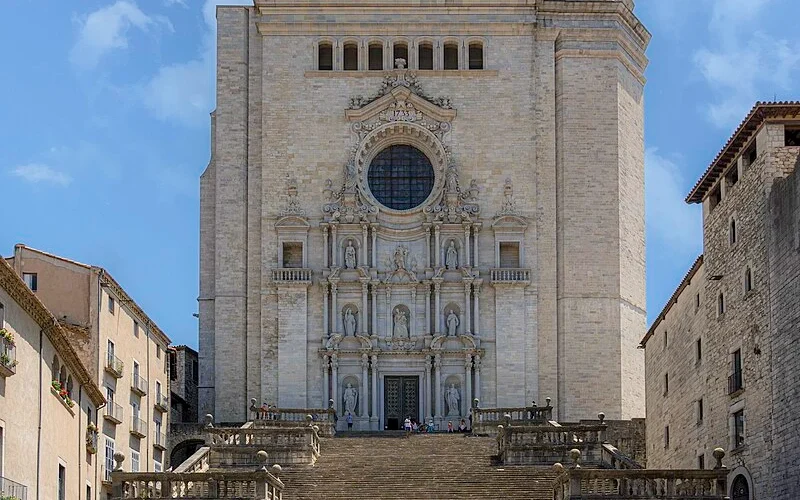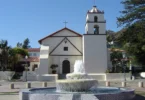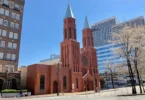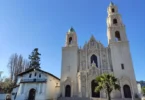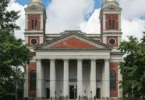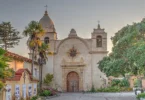Introduction
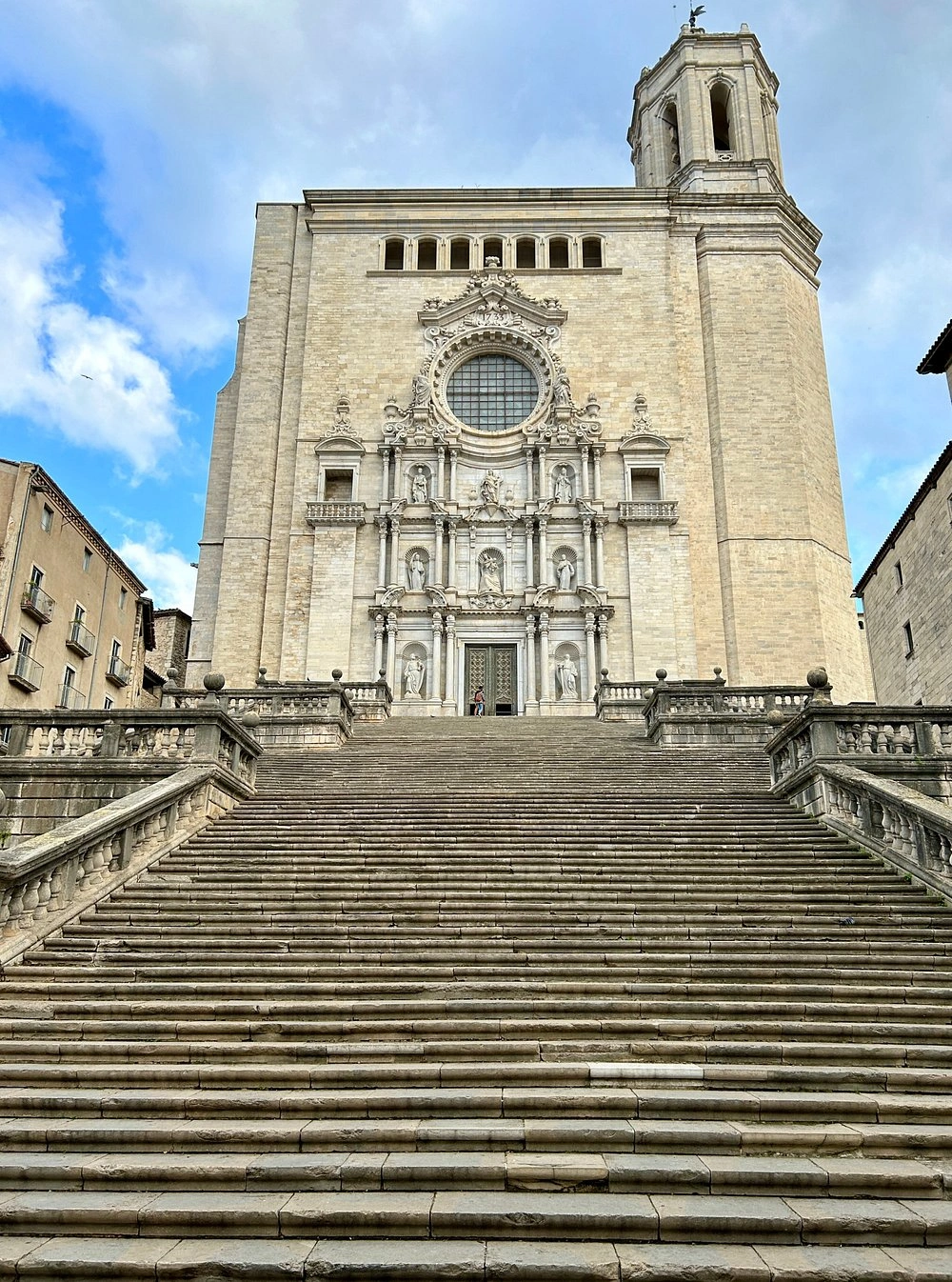
The Cathedral of Saint Mary, known in Catalan as Catedral de Santa Maria, stands prominently in Girona, Catalonia, Spain, as a remarkable example of Roman Catholic ecclesiastical architecture. Serving as the seat of the Roman Catholic Diocese of Girona, this cathedral is renowned for its architectural grandeur and historical significance. Its most striking feature is the interior’s widest Gothic nave in the world, measuring an impressive 23 meters (75 feet) in width, a testament to the ambitious Gothic design that defines much of its structure. Construction of the cathedral began in the 11th century, initially embracing the Romanesque architectural style. Over the following centuries, the building evolved, with significant work in the 13th century transitioning to the Gothic style that now characterizes its most iconic elements. Despite the extensive Gothic renovations, some original Romanesque features remain intact, including the 12th-century cloister and an early bell tower dating back to 1040. A second bell tower was later completed in the 18th century, further enriching the cathedral’s historic profile. The Cathedral of Saint Mary is strategically situated at the highest point in Girona, offering a commanding presence over the city. It is officially recognized as a Site of Cultural Interest, underscoring its cultural, architectural, and historical importance. Adjacent to the cathedral is the former Episcopal Palace, which today houses the Girona Art Museum, further contributing to the site’s significance as a cultural and artistic hub.
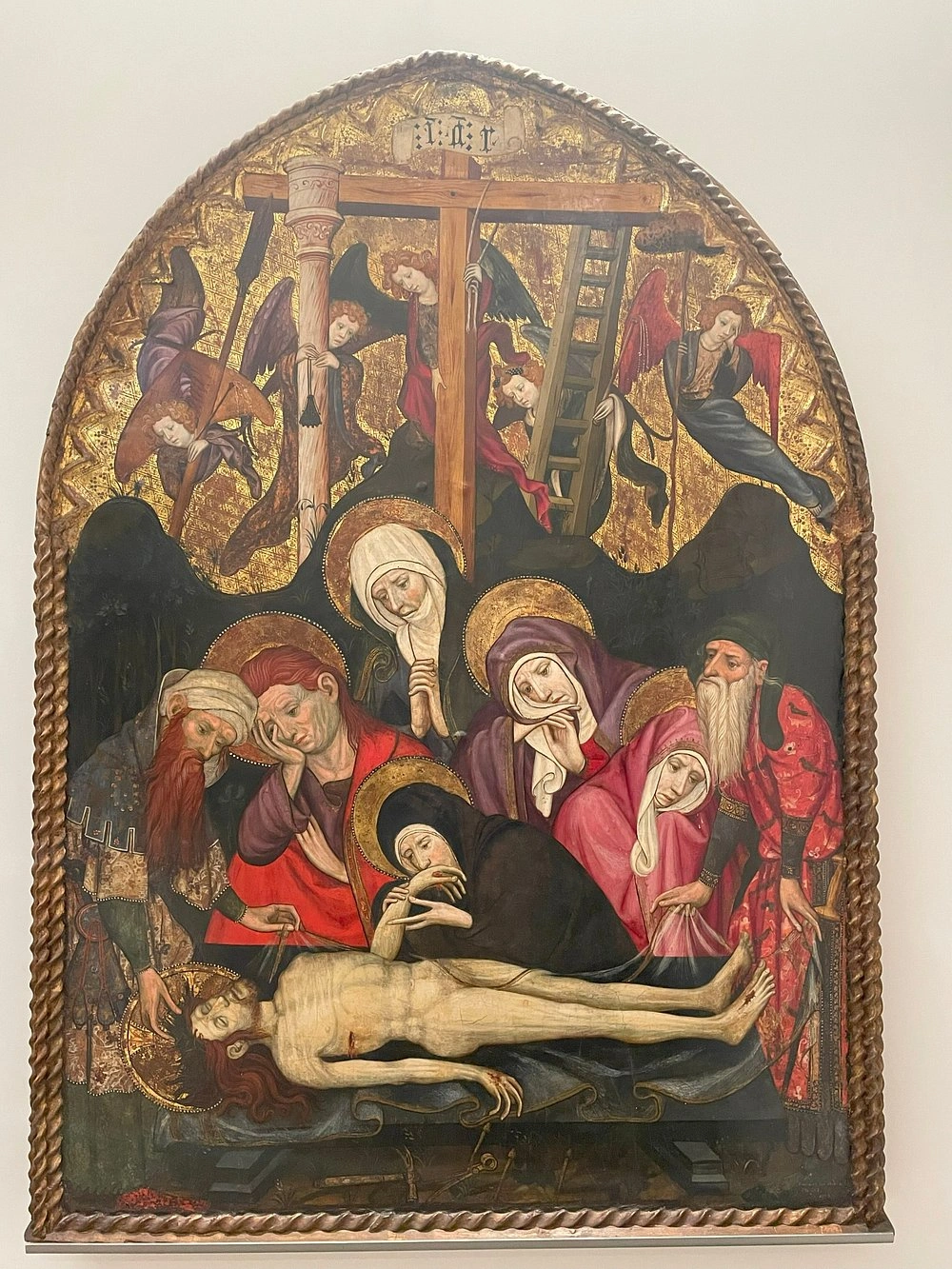
Early Christian Origins and Islamic Period
The site of the Cathedral of Saint Mary in Girona holds a long and complex history dating back to early Christianity in the region. Originally, a primitive Christian church stood here, serving as the seat of the local bishopric. This early church also governed the nearby sanctuary dedicated to the martyr deacon Saint Felix, which had been constructed near the city walls on the martyr’s tomb. In 717, during the Islamic conquest of the Iberian Peninsula, this Christian church was converted into a mosque as Girona came under Muslim control. This period lasted until 785, when the Franks, under Charlemagne’s command, reconquered the city. Subsequently, the church was reconsecrated as a Christian place of worship in 908, marking the restoration of Christianity in Girona.
Romanesque Cathedral (11th-12th Century)
By the early 11th century, specifically around 1015, the church was in a state of disrepair. Bishop Peter Roger, son of Count Roger I of Carcassonne and brother to Ermesenda of Carcassonne (Countess of Barcelona and Girona), undertook significant restoration efforts. To finance these repairs, he sold the church of Saint Daniel to his brother-in-law, Count Ramon Borrell of Barcelona, securing funds for reconstruction. Between 1019 and 1064, the church and its cloister were rebuilt in the Romanesque architectural style, a style characterized by solid, heavy walls and rounded arches. The bell tower, facing the south side of the cloister, began construction by 1081 and was completed in 1117. During this period, significant renovations were made to the chancel, which was rededicated in 1038. Artistic works from this era include the episcopal chair and the altar, both likely created by workshops from Roussillon. The altar was notably lavish, covered in gold financed by a special legacy from Countess Ermesenda.

Early Gothic Expansion (13th-14th Century)
By the late 13th century, the existing Romanesque chancel was considered insufficient for the liturgical needs of the time. In 1292, the cathedral chapter began planning an expansion, supported by a generous donation of 10,000 Catalan salaries from Treasurer Guillén Jofré.
The project officially commenced in 1312 under architect Pere Sacoma, focusing on extending the choir area with an ambulatory and nine surrounding chapels, commissioned by Enrique de Narbona. Following Narbona’s death, architects Jaime Faverán, Guillermo Cors, Francisco Saplana, and Pedro Sacoma contributed to the work, completing this section in 1347. The extension continued with architect Guillermo Monry, who finished the adjacent choir area by 1368. A transept was added to connect the new Gothic expansions with the remaining Romanesque structure, facilitating a smooth architectural transition.
Construction of the Wide Gothic Nave (15th-16th Century)
The most ambitious phase of the cathedral’s construction began in 1417 with plans to build a wide, single nave. Initially, there was debate among cathedral officials and master builders about whether to proceed with one or three naves. After fifty years of discussion, a consensus was reached to continue with a single nave, notable for its immense scale: 50 meters long, 23 meters wide (making it the widest Gothic nave in the world), and 34 meters high. The master builder Guillermo Bofill oversaw the construction, implementing advanced architectural techniques to support the vast open space. Although Bofill did not live to see its completion, work continued into the 16th century under master builder José Ferrer. This nave is unique in Gothic architecture due to its exceptional width and height, providing a powerful visual and spatial experience despite its relative austerity. Renowned architectural historian Nikolaus Pevsner described the cathedral’s design as a compelling example of the transition from pure to late Gothic style, highlighting the contrast between the vast single nave and the more complex eastern section with staggered chapels.
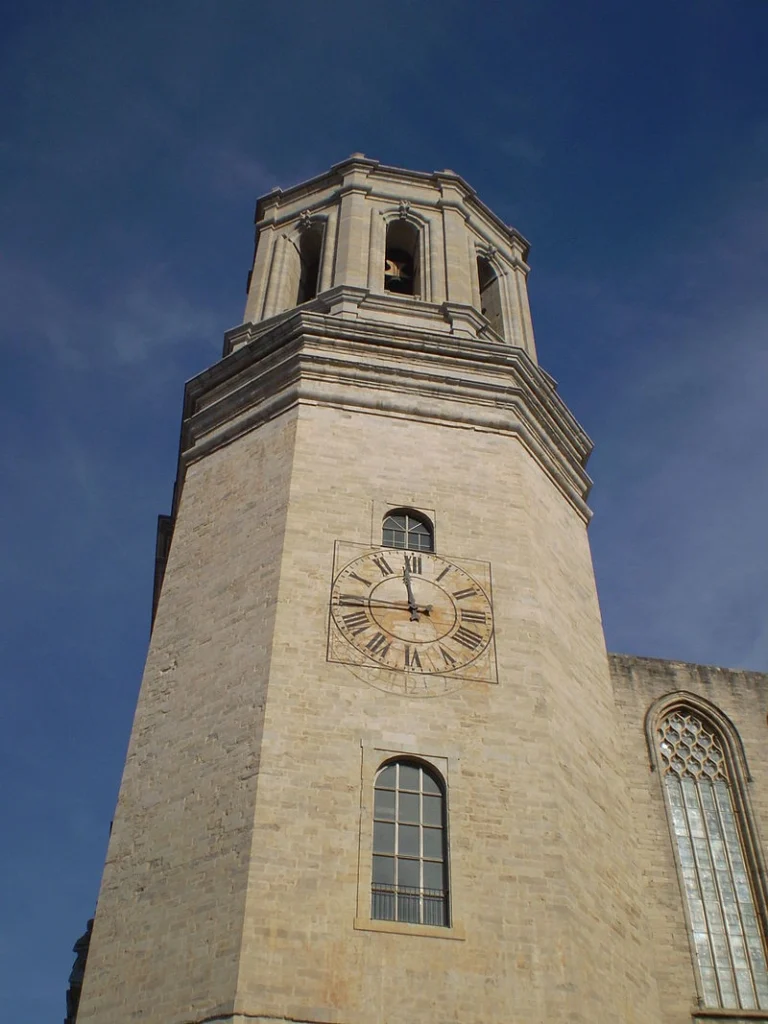
Later Modifications
In 1604, the original Romanesque frontispiece of the cathedral was demolished to accommodate the evolving architectural style and functionality of the building. The cathedral’s second bell tower was completed in the 18th century, adding to its architectural complexity.
Architecture of Cathedral of Our Lady, Girona, Spain
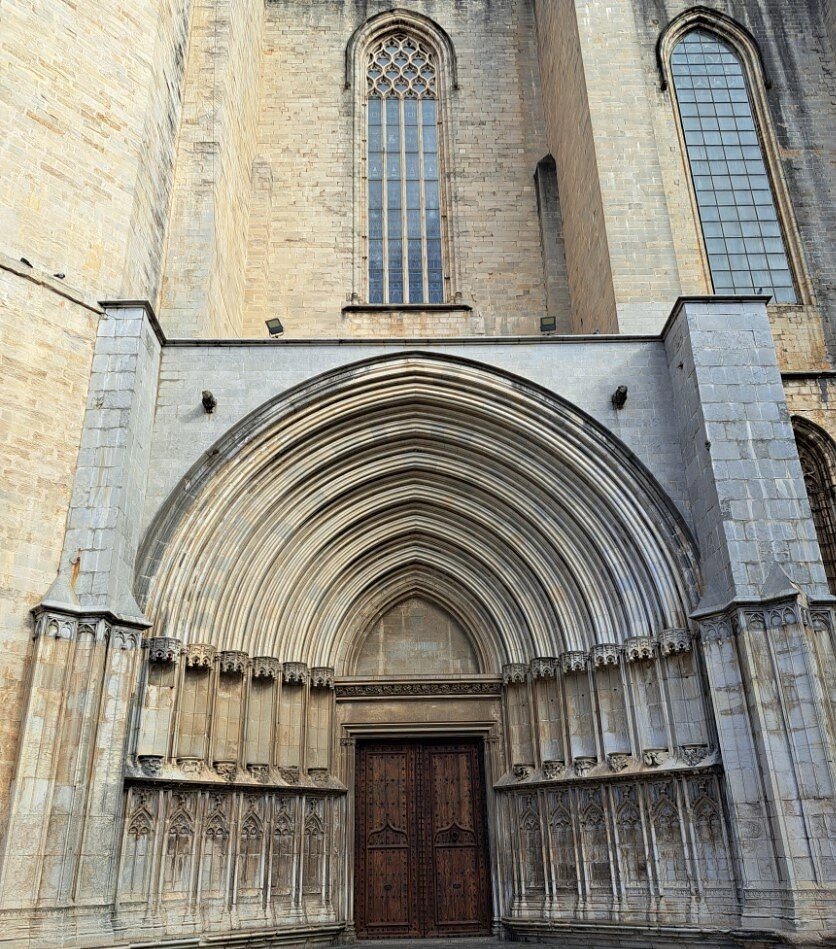
Architect : Guillermo Boffiy
Architectural style : Gothic architecture, Baroque architecture
Central Nave and Exterior Features
The cathedral’s façade, showcasing a Baroque style, was completed in 1730. The central staircase, which provides access to the main entrance, dates back to 1607. On the exterior, notable architectural elements include the Gothic portico of San Miguel on the north side and the Portico of the Apostles to the south, both originating from the 14th century. Sculptures added in the 15th century still adorn these portals. Prominently above the main chapel is the Romanesque episcopal cathedral from the 11th century, which houses the cathedral’s masterpiece: a silver gilt and enamel main altarpiece crafted by the Gothic goldsmith Bartomeu between 1320 and 1357. The cathedral treasury boasts other artistic treasures, including the famed Tapestry of Creation and a variety of sculptures. One of the key architects and sculptors of the 17th century involved in the cathedral’s construction was Pere Costa i Cases.
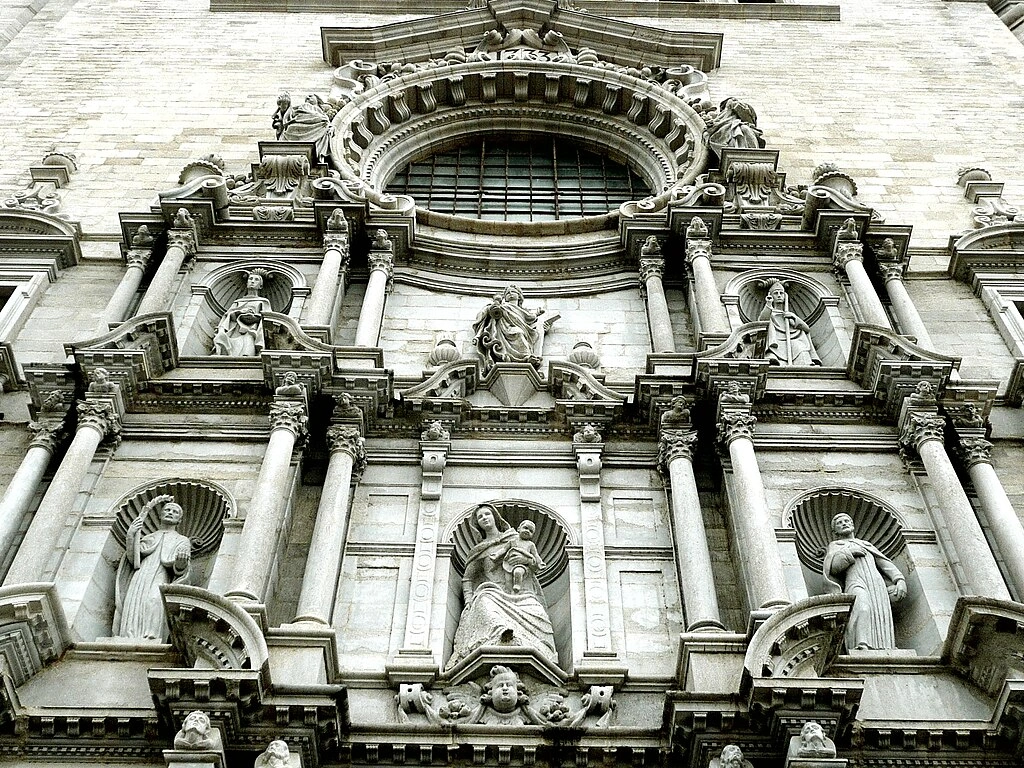
Main Façade
The foundation stone of the main façade was laid in 1606. However, construction progressed slowly due to intermittent halts, resuming notably in 1680 and finally reaching completion only by 1960. Following this, from 1960 to 1962, local sculptors Josep M. Bohigas, Antoni Casamor, Jaume Busquets, and Domènec Fita created monumental sculptures which were installed in the façade’s empty niches.
The façade is a splendid example of Baroque-Classical style. It is divided vertically into three sections resembling an altarpiece. At the top, a large oculus is crowned by a pediment, above which are seven openings with segmental or lowered arches. The niches within the three sections are framed by paired columns and house sculptures, most of which were crafted in the 20th century.
Interior Architecture
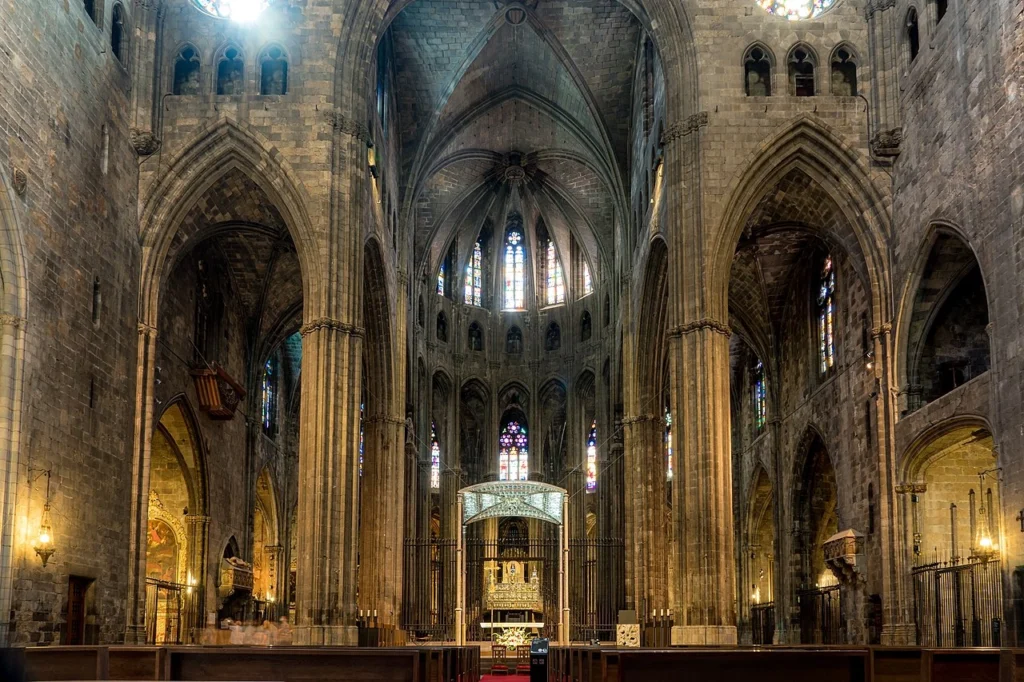
The interior boasts a magnificent single Gothic nave covered by a vaulted ceiling with diagonal arches. These vaults are supported by clusters of slender columns. Along the side buttresses in the nave’s first area, two chapels per bay are housed. Moving towards the presbytery, two bays feature large Gothic windows with clerestory windows running below them on both walls. A wall separates the nave from the presbytery, characterized by a central large pointed arch flanked by two smaller ones, with three oculi above: two smaller ones above clerestory windows and a larger one near the vault. The stained-glass windows in the presbytery date from the 16th century and depict scenes from the life of the Virgin Mary.
The Choir
The choir contains modest yet well-carved 16th-century choir stalls, which are considered somewhat simple compared to the cathedral’s grandeur. Among the choir’s important features is the bishop’s chair by Master Eloy, belonging to an earlier Gothic choir. Also preserved is the Romanesque bishop’s chair, carved from a single piece of marble. The choir houses a modern organ, built in 1943, which replaced the original 16th-century instrument constructed by Master J. Bordons.
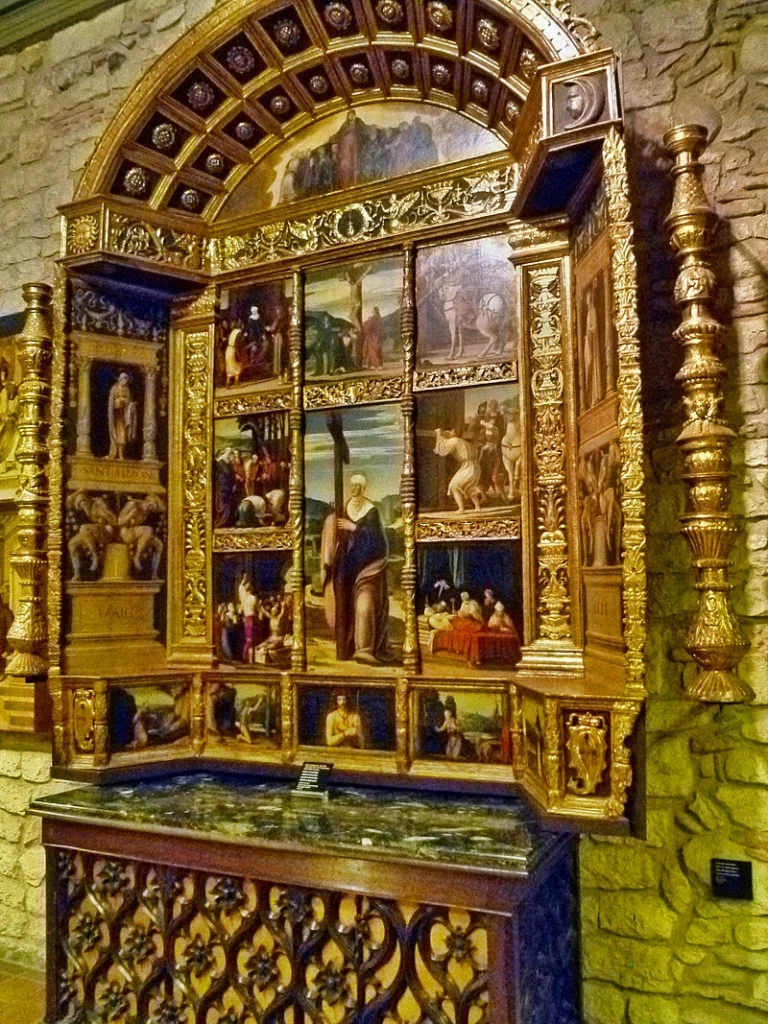
Presbytery
Located within the presbytery is the main chapel, distinguished by its original 14th-century silver-covered altarpiece — a masterpiece of Gothic goldsmithing. Work on the altarpiece began in 1325 by Master Bartomeu, continued by Ramón Andreu de Gerona, and completed around 1358 by Pedro Bernés. The altarpiece narrates the life of Jesus Christ and culminates in three figures beneath a Gothic canopy, the central one depicting the Virgin and Child. The altarpiece is richly adorned with silver plating and enamel, protected by a silver canopy supported by four columns, made between 1320 and 1326, likely by the same artists. The chapel’s altar is a significant Romanesque piece supporting the carved marble slab (measuring 2.5 m by 1 m). This altar once featured a richly decorated frontal, a bequest from Countess Ermesinda, made of alabaster with gilded relief scenes and precious stones. Unfortunately, it was sold in 1809 to French troops for one million francs to pay imposed tributes during the Napoleonic Wars.

Stained Glass Windows and the Saladriga Rose Window
One of the cathedral’s most remarkable stained-glass features is the Saladriga Rose Window, a large north-facing window measuring 14 meters high by 3 meters wide. The cathedral originally contained three distinct types of stained glass windows: the oldest, attributed to the Master of the Presbytery, created during the early phases of construction; windows by Guillem de Letumgard from the mid-14th century, including the notable Calvary window in the ambulatory and a large south-facing window by Antoni Thomas; and finally, additions from the 20th century, including two exquisite rose windows crafted in the early 18th century by Francesc Saladriga, celebrated as some of the finest Spanish Baroque stained glass art. In the mid-18th century, many windows, particularly the rose windows and more modern glass, were destroyed under unclear circumstances. Restoration efforts followed quickly but employed techniques that unfortunately caused the colors to fade and the original details to diminish over time. By the late 20th century, a new restoration strategy was adopted, focusing on preserving surviving fragments rather than recreating lost parts. This approach aimed to reduce the overwhelming presence of white glass, improve the interplay of light, and partially recover the biblical narratives once depicted, though some artistic and symbolic elements were irrevocably lost. In July 2011, the restoration culminated with the inauguration of the last stained glass window on the north façade, previously sealed off. This contemporary window, created by Irish artist Sean Scully, features abstract motifs that complement the cathedral’s historic stained glass, marking the completion of restoration on the building’s most deteriorated side.
Tombs and Funerary Art
Girona Cathedral houses an extensive and impressive collection of funerary monuments scattered throughout its interior and cloister, commemorating bishops, royalty, counts, artists, architects, and other notable figures, many of which are remarkable works of art. Among the most significant is the tomb of Bishop Bernard of Pau (died 1475) in the Chapel of St. Paul, an outstanding example of 15th-century florid Gothic funerary sculpture. This elaborate monument is divided into three sections featuring tenant figures with the bishop’s coat of arms, a crowned Virgin Mary surrounded by attendants including the bishop, and a richly decorated mortuary bed portraying the bishop in pontifical robes, flanked by angels carrying his soul to heaven. The tomb of Bishop B. Vilamarí, located in the Chapel of All Saints and carved by Jaime Faverán, is distinguished by the singular presence of his recumbent figure. Near the presbytery steps, Bishop Berenguer de Anglesola is memorialized in an alabaster tomb with figures of mourners under delicate canopies, showing him vested with a mitre. The tomb of Count Ramon Berenguer II of Barcelona stands in the ambulatory near the sacristy door, depicting him in warrior armor resting on a sarcophagus adorned with carved shields; his wife Mahalda’s tomb is nearby. Both were created in the 14th century by Guillermo Morell under the commission of King Pedro IV of Aragon. The cathedral’s architect, Guillermo de Villamar, is commemorated with a tomb designed by Jaime Faverán dating from 1322, while Arnaldo de Monredó’s tomb, located at the back of the temple, is notable for its intricate openwork Gothic tracery. Ramón Bofill is buried in the Chapel of Hope, formerly the cloister’s refectory. Additional tombs from the 13th to 16th centuries are found in the chapels of San Bernardo, Santa Marta, San Isidro, Esperanza, and Santa Elena, along with numerous tombstones and sarcophagi laid in the cloister galleries, collectively showcasing a rich heritage of funerary art spanning several centuries.
Museum Collection
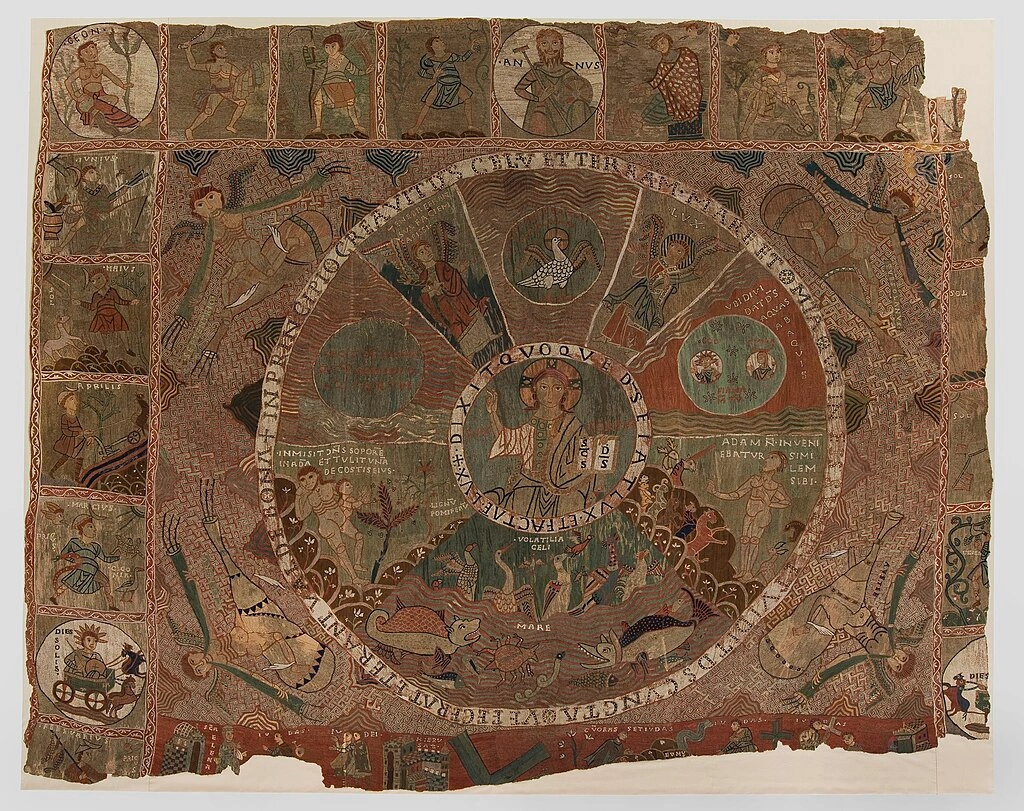
Housed within the chapter house and sacristy, the Girona Cathedral museum preserves a remarkable and diverse collection of artworks and historical artifacts accumulated over centuries by the cathedral chapter. Among its most prized treasures is the Tapestry of Creation, a unique Romanesque masterpiece depicting vivid biblical scenes. The museum also houses the Hisham II Casket, a luxurious 10th-century artifact from Medina Azahara, originally a gift from Caliph Al-Hakam II to his heir Hisham II, later repurposed as a reliquary. The Beatus of Gerona is another highlight—a rare 10th-century manuscript featuring the Commentaries on the Apocalypse, illuminated by the nun Ende and the monk Emeterio. The collection includes the Usatges of Catalonia, a 12th-century manuscript of Catalan legal codes, and the Saint Charlemagne, a Gothic polychrome alabaster statue traditionally identified as Charlemagne but now thought to represent Peter the Ceremonious, crafted by Jaume Cascalls de Berga. Valuable works of goldsmithing, such as crosses, monstrances, and reliquaries from the 13th to 15th centuries, further enrich the collection. The Wooden Virgin Mary, a 12th-century statue covered in silver sheets and originally part of the Romanesque presbytery, stands as a testament to early devotional art. The Custody of Corpus Christi, a gilded silver masterpiece created in 1438 by Francesc Artau, is accompanied by four large processional crosses dating from the 14th to 16th centuries. Additionally, the museum preserves the Seal of Countess Ermesenda of Carcassonne, dating to the late 10th century, notable for bearing her name inscribed in both Latin and Arabic, reflecting the historical significance of her patronage.
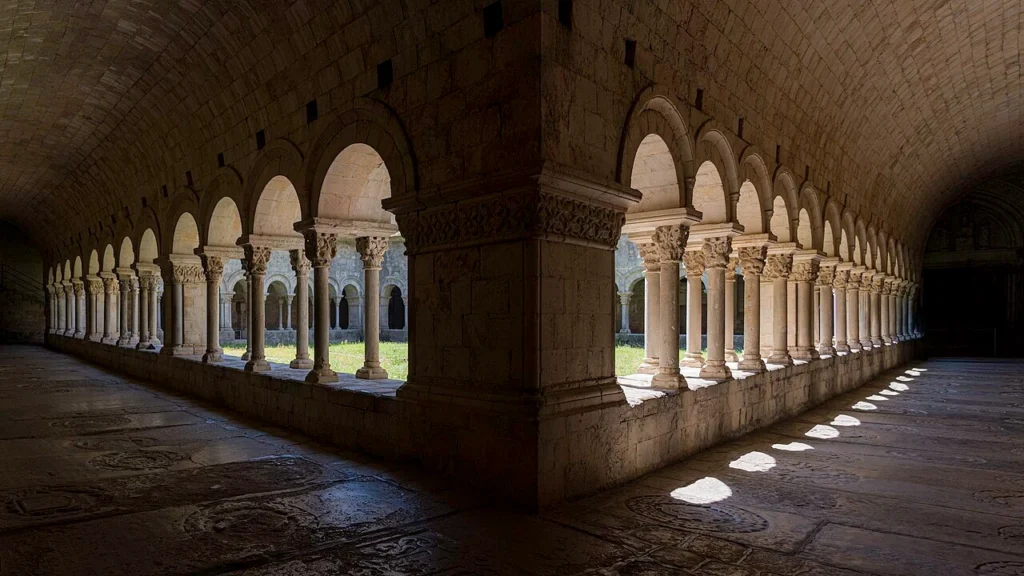
The Cloister
The Romanesque cloister, attributed to sculptor Arnau Cadell, dates from the 12th century. It features a trapezoidal floor plan influenced by earlier structures and the cathedral’s northern façade. The cloister arcades rest on double columns with jambs and are decorated with capitals featuring historiated, vegetal, and zoomorphic motifs. Within the cloister is the Chapel of the Virgin of Bell Ull, featuring a carving by Master Bartomeu. The cloister stands out as one of the most important artistic and sculptural complexes among Catalan monastic buildings.
Sculpture
Angel
At the very top of the cathedral stands a sculpted figure of an angel. Originally, this figure was intended to represent Faith, evidenced by its eyes being covered with a blindfold, symbolizing belief without sight. However, during a later restoration, the angel’s head was replaced with one without a blindfold. This change was made because, from the considerable distance at which the figure is viewed, the blindfold was not visible, and the figure was universally recognized as an angel due to its prominent wings. This artistic adjustment helped clarify the identity of the sculpture while preserving its spiritual symbolism.
Stone Witch
Known as the Witch of the Cathedral, the Stone Witch is a unique gargoyle located next to the Charlemagne Tower. Unlike the other gargoyles, this one is shaped like a human figure. According to local legend, the stone witch was once a woman who practiced dark arts and openly expressed her hatred for religion by throwing stones at the cathedral. As a result of a divine intervention, she was transformed into stone and placed on the cathedral as a gargoyle. This transformation was meant to silence her curses and insults, allowing only clean rainwater to flow from her mouth, serving as a lasting symbol of protection over the sacred building.
Feast Day
Feast Day : 15 August
The Cathedral of Our Lady of Girona (Catedral de Santa Maria) is dedicated to Mary, the Mother of Jesus. The main feast celebrated at the cathedral is the Feast of the Assumption, which takes place on August 15 each year. This feast honors the belief that Mary was assumed into heaven, body and soul. It is the cathedral’s principal liturgical celebration.
Church Mass Timing
Monday to Saturday : 9:00 am
Sunday : 10:30 am, 11:00 am
Church Opening Time:
Monday to Friday : 10:00 am – 5:30 pm.
Saturday : 10:00 am – 6:30 pm.
Sunday : 12:00 pm – 5:30 p m.
Contact Info
Address : Cathedral of Our Lady
Pl. de la Catedral, s/n, 17004 Girona, Spain.
Phone : +34 972 42 71 89
Accommodations
Connectivities
Airway
Cathedral of Our Lady, Girona, Spain, to Girona–Costa Brava Airport (GRO), distance 24 min (16.7 km) via N-2.
Railway
Cathedral of Our Lady, Girona, Spain, to Girona Plaça d’Espanya, distance between 9 min (2.2 km) via Passeig Fora Muralla.

